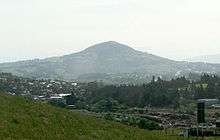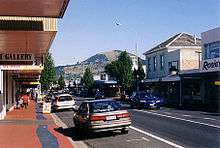Saddle Hill (New Zealand)
Saddle Hill is a prominent landmark overlooking the northeastern end of the Taieri Plains in Otago, New Zealand. Within the limits of Dunedin city, it is located 18 kilometres to the west of the city centre, between Mosgiel and Green Island, and is clearly visible from many of the city's southern hill suburbs. A lookout on the northern slopes of the hill commands a good view across the plains, with Lake Waihola visible 25 kilometres to the west in clear weather.


The hill has two peaks: the eastern is the higher, rising to 473 metres; the western peak – Jaffrays Hill – rises to 431 metres.
Of largely volcanic origin, the hill is part of the extinct Dunedin Volcano complex, with a base of Cretaceous breccia overlaid with Miocene igneous rocks, these in turn overlaid with Cenozoic sediments.[1] Erosion has revealed a volcanic plug on the western peak, giving the hill its distinct breast-like shape.
The hill was – along with Cape Saunders on the Otago Peninsula – one of just two places in Otago to have been named by Captain James Cook on his 1769 voyage of discovery. Cook described the hill in his journal as "a remarkable saddle". According to pre-European Māori tradition, the hill is the remains of a taniwha called Meremere[2] and the northern and southern peaks of hill were known by Māori by the names Makamaka and Pikiwara respectively. Early settlers' maps occasionally record the hill as "Saddleback Hill".[3]
A small coal seam on the hill was exploited by early European settlers, and was mined from as early as 1849, the first coal mine in the country.[4] Jaffrays Hill (often wrongly called Jeffrey's Hill, and named for the Jaffray family who owned the land from 1849 until 1937),[3] was extensively mined for basalt gravel until the mid-1980s. A DCC landscape architect reviewed the visual effects of quarrying in 2008 after concerns from local residents, and found the hill to be "relatively unchanged".[5] This finding, however, has been successfully challenged in court[6] with much public opinion against[7] the continued quarrying.
References
- Bishop, D.G. and Turnbull, I.M. (1996). Geology of the Dunedin area. Lower Hutt: Institute of Geological and Nuclear Sciences. ISBN 0-478-09521-X
- Dann, C. and Peat, N. (1989) Dunedin, North and South Otago. Wellington: GP Books. p. 64. ISBN 0-477-01438-0
- Herd, J. and Griffiths, G.J. (1980) Discovering Dunedin. Dunedin: John McIndoe. p. 103. ISBN 0-86868-030-3
- Dunmore, Patricia (ed.) (1977). The Dunmore Book of New Zealand Records. p. 22. ISBN 0-908564-08-2.CS1 maint: extra text: authors list (link)
- Schofield, Edith (16 September 2008). "Saddle Hill 'relatively unchanged', says DCC". Otago Daily Times. Retrieved 15 September 2008.
- RadioNZ (17 October 2016). "Environment court decides in Council's favour".
- "Save Saddle Hill".
External links
![]()